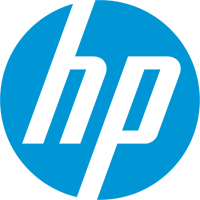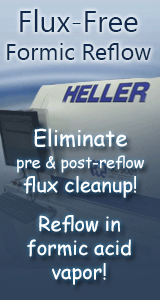Electronics Manufacturing Technical Articles
Papers and articles related to SMT, PCB & EMS industry.
- SMTnet
- »
- Technical Library
1432 SMT / PCB Assembly Related Technical Articles

Flex (Flextronics International)
Flextronics is a global full-service supplier of a full spectrum of value-added Electronic Manufacturing Services.
Singapore, Singapore
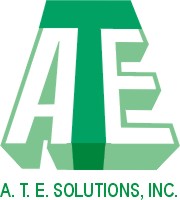
The leading Test, ATE and Testability consulting and educational firm, offering various test related courses. Maintains the BestTest Directory, a test community knowledge base. Publishes The BestTest eNewsletter.
Los Angeles, California, USA
Consultant / Service Provider, Manufacturer, Training Provider

A leader in software solutions for electroncs design, Mentor Graphics is the only EDA company with a total end-to-end solution for design though manufacturing.
Wilsonville, Oregon, USA

Reduce electrical overstress (EOS) with our EMI filters for soldering, power, ground and servo motors. EMI filters improve equipment up-time and reliability and reduce test problems.
Santa Cruz, California, USA

CableEye® continuity and HiPot pass/fail & diagnostic Cable & Harness Test Systems w simple scripting, labeling, documentation, cataloging & relay control. Dynamically display continuity, Ω, diodes, IR, dielectric breakdown & more
Acton, Massachusetts, USA
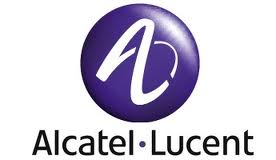
Alcatel-Lucent- Enterprise Business Group is a world leader in the delivery of communications solutions for businesses, including contact center software, small/medium business telephony and IP addres
Calabasas, California, USA

Panasonic Factory Solutions Company of America (PFSA)
PFSA develops and supports innovative manufacturing automation equipment, processes and solutions around the core of electronic assembly, microelectronic, software and circuit manufacturing
Rolling Meadows, Illinois, USA

Intrinsiq Materials manufactures a variety of electronic ink, including screen-printable, and inkjetable copper ink, a silicon ink jet, and a nickel ink jet.
Rochester, New York, USA

The globally leading provider of high precision cleaning products, services and training solutions in the electronics and semiconductor manufacturing industries.
Manassas,
Consultant / Service Provider, Manufacturer, Training Provider

AIM is a leading global manufacturer of tin-lead and lead-free solder assembly materials for the electronics industry.
Montreal, Quebec, Canada

Global manufacturer of XPM Reflow Ovens, ZEVA Selective Soldering and Delta Wave Soldering Equipment.
Camdenton, Missouri, USA

A global electronic measurement technology and market leader helping to transform its customers' measurement experience through innovations in wireless, modular, and software solutions.
Santa Rosa, California, USA

With numerous facilities in the United States, we are one of the electronics industry's leading manufacturers of lead-free solder products, superior quality stencils, and precision cut parts.
Greeley, Colorado, USA

YINCAE Advanced Materials, LLC.
Yincae Advanced Materials, LLC is a developer, manufacturer, and supplier of high performance coatings, adhesives, electronic and optoelectronic materials.
Albany, New York, USA

YINCAE Advanced Materials, LLC.
Yincae Advanced Materials, LLC is a developer, manufacturer, and supplier of high performance coatings, adhesives, electronic and optoelectronic materials.
Albany, New York, USA

YINCAE Advanced Materials, LLC.
Yincae Advanced Materials, LLC is a developer, manufacturer, and supplier of high performance coatings, adhesives, electronic and optoelectronic materials.
Albany, New York, USA

YINCAE Advanced Materials, LLC.
Yincae Advanced Materials, LLC is a developer, manufacturer, and supplier of high performance coatings, adhesives, electronic and optoelectronic materials.
Albany, New York, USA

YINCAE Advanced Materials, LLC.
Yincae Advanced Materials, LLC is a developer, manufacturer, and supplier of high performance coatings, adhesives, electronic and optoelectronic materials.
Albany, New York, USA

YINCAE Advanced Materials, LLC.
Yincae Advanced Materials, LLC is a developer, manufacturer, and supplier of high performance coatings, adhesives, electronic and optoelectronic materials.
Albany, New York, USA

YINCAE Advanced Materials, LLC.
Yincae Advanced Materials, LLC is a developer, manufacturer, and supplier of high performance coatings, adhesives, electronic and optoelectronic materials.
Albany, New York, USA

Nissin supplies electron element materials, anisotropic conductive films, direct-current power supply systems, uninterruptible power supplies.
Nishinomiya, Japan

Flex (Flextronics International)
Flextronics is a global full-service supplier of a full spectrum of value-added Electronic Manufacturing Services.
Singapore, Singapore

World's premier measurement company, providing the critical tools and technologies that sense, measure, and interpret the physical and biological world.
Loveland, Colorado, USA

Schleuniger, Inc. is a leading manufacturer of wire processing equipment. Our innovative automatic and semi-automatic machines are designed to cut, strip, crimp and mark all types of wire and cable.
Manchester, New Hampshire, USA

Semiconductor Company which design FBGA and its own PCB Board to test our chips.
Bayan Lepas, Penang, Malaysia

BFK Solutions, the industry leader in critical cleaning consulting, helps manufacturers achieve the best choices for reliable, value-added, cost-effective product cleaning.
Pacific Palisades, California, USA

Flex (Flextronics International)
Flextronics is a global full-service supplier of a full spectrum of value-added Electronic Manufacturing Services.
Singapore, Singapore

Lockheed Martin is a global security and aerospace company that employs about 112,000 people worldwide and is principally engaged in the research, design, development and manufacturing of advanced technology systems.
Bethesda, Maryland, USA

Manufacturer of advanced process chemistry for plating, masking and stripping. Custom manufacturing of automated equipment for electrodeposion including; hoist systems, reel-to-reel and continuous vertical processing equipment.
Cranston, Rhode Island, USA
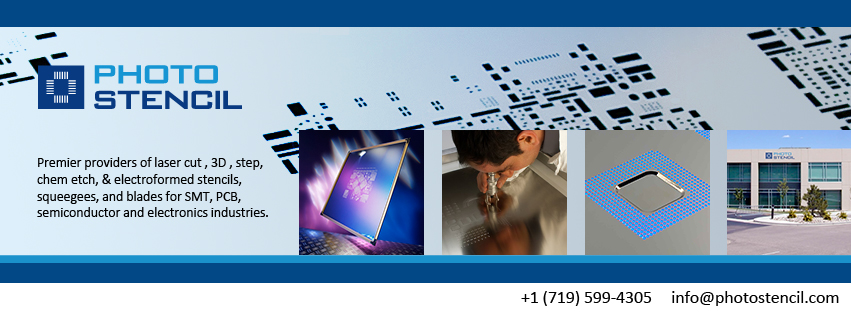
Photo Stencil provides high-performance stencils, squeegee blades, thick film and metal mask screens and tooling for the surface mount technology (SMT) assembly, solar, and semiconductor industries.
Colorado Springs, Colorado, USA

Alcatel-Lucent- Enterprise Business Group is a world leader in the delivery of communications solutions for businesses, including contact center software, small/medium business telephony and IP addres
Calabasas, California, USA

Lockheed Martin is a global security and aerospace company that employs about 112,000 people worldwide and is principally engaged in the research, design, development and manufacturing of advanced technology systems.
Bethesda, Maryland, USA

Bergquist, now a part of Henkel, supplies thermal-management solutions for electronic applications, serving a variety of industries ranging from automotive to consumer and industrial electronics as well as LED lighting.
Chanhassen, Minnesota, USA

Intel designs and builds the essential technologies that serve as the foundation for the world's computing devices.
Santa Clara, California, USA

Ericsson AB manufactures and markets radio and television communication equipment. The company was formerly known as Ericsson Radio Systems AB. Ericsson AB (Sweden) operates as a subsidiary of Ericsson.
Stockholm, Sweden

Flex (Flextronics International)
Flextronics is a global full-service supplier of a full spectrum of value-added Electronic Manufacturing Services.
Singapore, Singapore

Pioneers in the area of solderless assembly technology and originators of the OCCAM process. Developing IP for next and future generations of high reliability and better performing electronic products.
Seattle, Washington, USA

Albemarle is a leading specialty chemical company providing innovative chemistry solutions to customers in over 100 countries around the world.
Baton Rouge, Louisiana, USA

Smoltek offers a proprietary conductive nano-scale carbon technology tailored to support the future needs of the semiconductor industry.
Gothenburg, Sweden

BEST offers professional rework, repair and prototype builds of PCBs. Our expertise is on BGA rework and QFN rework. Our experienced instructors teach professional soldering classes as we are an IPC certified training center
Rolling Meadows, Illinois, USA

Founded in 1992, LaserJob specializes in laser-cut stencils for printed circuit boards used in electronic devices.
Fürstenfeldbruck, Germany

ETS - Energy Technology Systems, Inc.
Manufacturer of Fluid Dispensing Equipment for Selective Conformal Coating, Potting, Encasulation & Underfill including Inspection, Conveying and Curing. Total Solution Fluid Dispensing & Conformal Cocating Process Lines.
Deer Park, Washington, USA

A multinational electronics manufacturing services (EMS) company.
Toronto, Ontario, Canada
Manufacturer, Standards Setting / Certification, Training Provider

ETS - Energy Technology Systems, Inc.
Manufacturer of Fluid Dispensing Equipment for Selective Conformal Coating, Potting, Encasulation & Underfill including Inspection, Conveying and Curing. Total Solution Fluid Dispensing & Conformal Cocating Process Lines.
Deer Park, Washington, USA

ETS - Energy Technology Systems, Inc.
Manufacturer of Fluid Dispensing Equipment for Selective Conformal Coating, Potting, Encasulation & Underfill including Inspection, Conveying and Curing. Total Solution Fluid Dispensing & Conformal Cocating Process Lines.
Deer Park, Washington, USA

ETS - Energy Technology Systems, Inc.
Manufacturer of Fluid Dispensing Equipment for Selective Conformal Coating, Potting, Encasulation & Underfill including Inspection, Conveying and Curing. Total Solution Fluid Dispensing & Conformal Cocating Process Lines.
Deer Park, Washington, USA

Schleuniger, Inc. is a leading manufacturer of wire processing equipment. Our innovative automatic and semi-automatic machines are designed to cut, strip, crimp and mark all types of wire and cable.
Manchester, New Hampshire, USA



